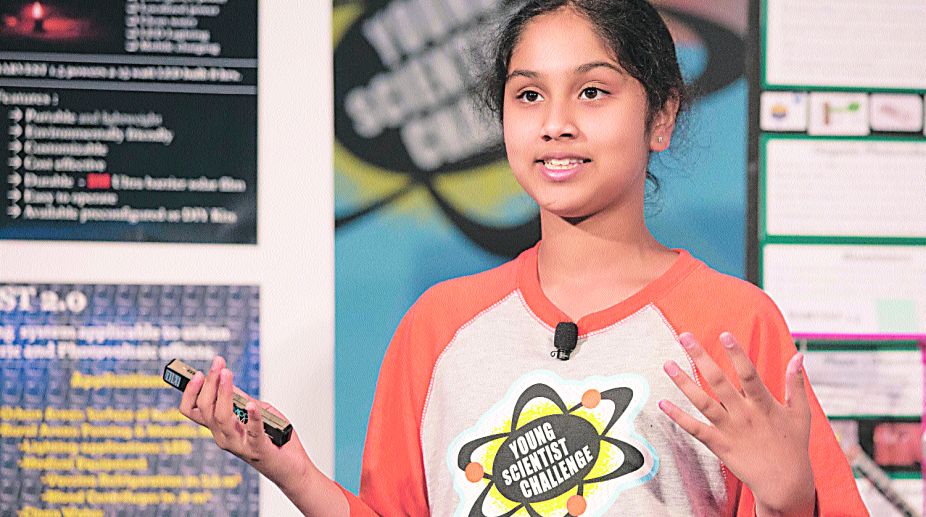In January 2015, students in south India displayed remarkable initiative at a civic festival. Ten students from East/West School, Bengaluru, lit street lamps by walking on special footpaths — they focused on piezo-electric energy with tiles powered by this form of electricity. These tiles, manufactured by a UK-based company, gave 0.05 watts of electricity, to light street lamps over a certain distance. The converted mechanical energy made this concept possible by providing the requisite power for lighting a street.
We are assailed by an obvious question: what is piezoelectric energy? It is an electric charge which accumulates in certain types of solid matter. Piezo-electricity was discovered in 1880, by French physicists, Jacques and Pierre Currie. Their discovery was all about converting available energy from the environment — that allows self sufficient energy supply, for small amounts of electric loads such as sensors and radio transmitters. Kinetic energy is the energy of motion of a body or system, so this can be converted into electric energy by virtue of the piezo-electric effect. Piezo elements convert the kinetic energy from vibrations or shocks into electric energy. This explains how those students in Bengaluru, precipitated piezoelectricity by walking on tiles, which accumulated and then provided electricity for street lights. Each tile, however, costs Rs 40,000.
Advertisement
But let us not despair about the costs involved because another student, Maanasa Mendu, who is an Indian-origin US school-goer, has created a model, which accumulates piezo-electricity and costs a mere five dollars. Mendu, a 13-year-old girl, has displayed extraordinary application of mind and her achievement is remarkable — it exemplifies the fact that the answer to India’s energy needs could indeed be blowing in the wind.
Mendu from Ohio, USA, has presented Harvest, her prototype renewable energy gathering device at the Young Scientist Challenge. This is a tale involving an unusual pursuit by Mendu, who visited her grandparents in rural India and observed something in their home, which certainly never occurred in the US. The electricity supply went off almost every day and remained so for hours at a stretch. It was summer in India and a fan was desperately needed. A small battery inverter could barely function since the electricity which returned for a few hours, did not suffice to charge the battery. Power cuts in rural India are common because the electricity is diverted elsewhere. Mendu empathised with millions of people who were compelled to endure this hardship, and as a substitute used kerosene lighting. This was the backdrop that helped formulate Mendu’s creation, elucidating her sense of determination and intelligence. Her design of Harvest mimics a small outline of a tree that uses piezo-electric energy harvesters to capture power from the wind and rain. Mendu’s device utilises “solar leaves” plants to gather vibration energy. The entire concept works via solar cells and piezo-electric material, or material that generates electricity currents when exposed to movement or vibration; so when the weather is rainy, windy or even sunny, the device can gather energy.
Mendu’s ambition is to expand the future of Harvest for commercial distribution. She named this design Harvest since it is made to harness solar and wind power to provide cost efficient energy. Discovery Education’s chief executive officer, Bill Goodwyn, said, “Each year, the Discovery Education 3M Young Scientist Challenge reminds us of the inspiring ingenuity that results when we empower our youngest generation to apply science critical thinking, and motivate to solve real-world problems. Discovery Education is honoured to stand alongside 3M in congratulating Maanasa and the rest of the year’s finalists on their impressive innovations that foreshadow a bright future for our own nation.” Mendu received a cash award of $ 25,000, from Discovery Education 3M, as for her creation.
This chapter is likely to be a beginning for Mendu’s journey towards reaching greater goals for mankind. Renewable energy was an important item in the agenda of The 2015 United Nations Climate Change Conference, held in Paris, and all nations were advised to create and follow plans for a safer world with a healthy environment ensuring lower levels of CO2 emissions. The recently identified Anthropocene Era has affirmed that mankind alone can save the environment and it is dynamic proposals, like Harvest, which needs to be encouraged and developed.











